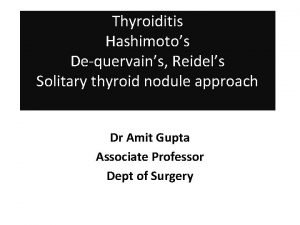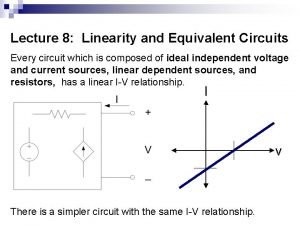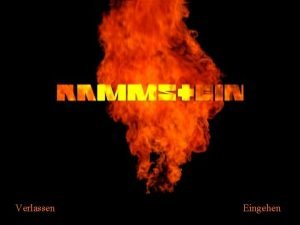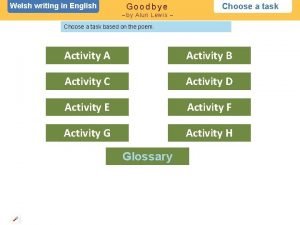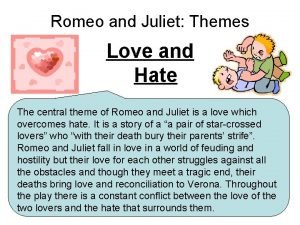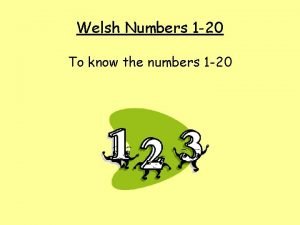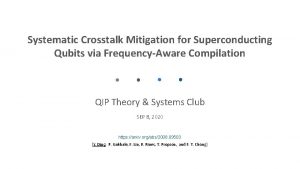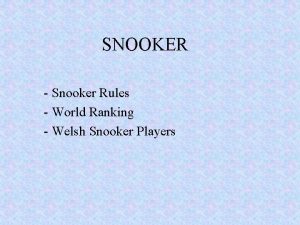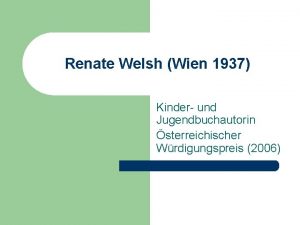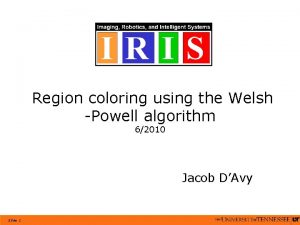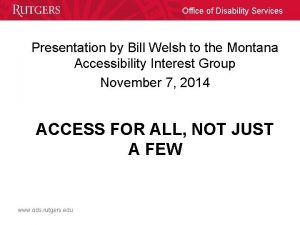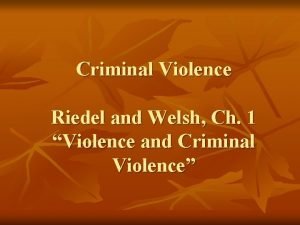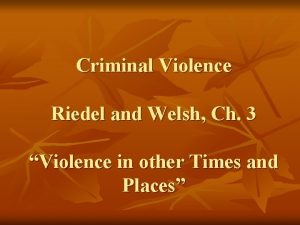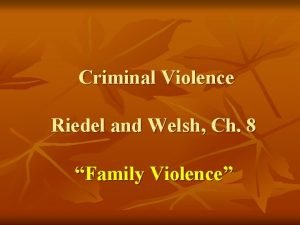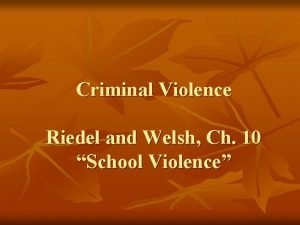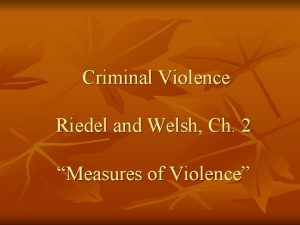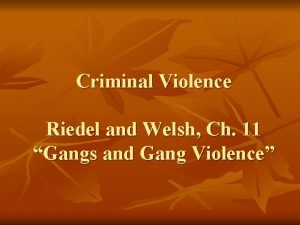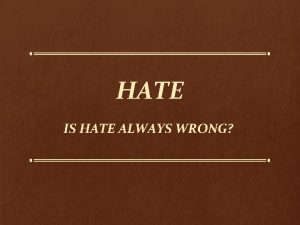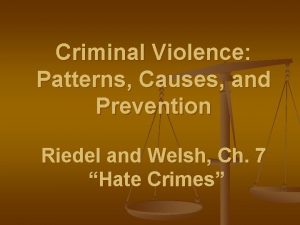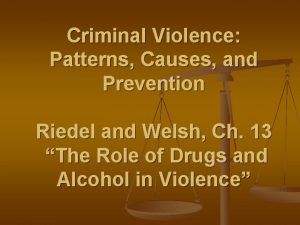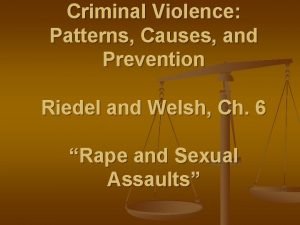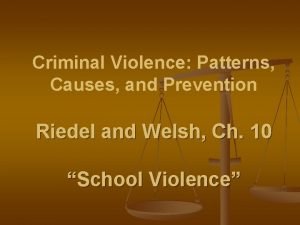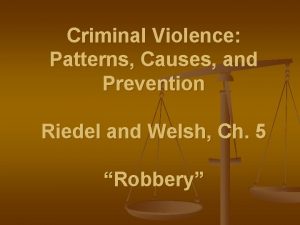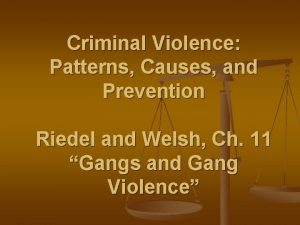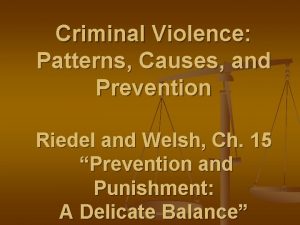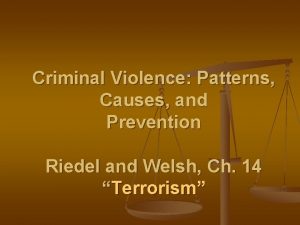Criminal Violence Riedel and Welsh Ch 7 Hate





















- Slides: 21

Criminal Violence Riedel and Welsh, Ch. 7 “Hate Crimes”

OUTLINE PATTERNS AND TRENDS n Hate Crimes Statistics Act EXPLANATIONS n Group conflict theories n Strain theory n Social learning theories INTERVENTIONS n Specialized police bias units n Hate crime legislation (state and federal) n Civil remedies n Teaching tolerance

Hate Crimes Statistics Act A whole new category of crime was created with passage of the Hate Crime Statistics Act (HCSA) of 1990. The HCSA required the collection of nationwide hate crime data for the first time. The goals of the act were to n n n n gather information on the frequency, location, extent, and patterns of hate crime increase law enforcement awareness of problem and responses to it raise public awareness of the problem send a message that the government is concerned about hate crime

Hate Crimes Statistics Act (cont. ) n n n The HCSA requires the FBI to collect and report data on hate crimes involving the predicate offenses of murder, nonnegligent manslaughter, forcible rape, aggravated assault, simple assault, intimidation, arson, and vandalism. A predicate offense means two things: (1) a criminal offense has occurred and (2) that offense was motivated wholly or in part by prejudice. For criminal conduct to be a hate crime, then, it must be motivated by prejudice.

Hate Crimes Statistics Act (cont. ) HCSA defines a hate crime as n “a criminal offense committed against a person or property, which is motivated, in whole or in part, by the offender’s bias against a race, religion, ethnic/national origin group, or sexual orientation group. ” Bias, according to FBI guidelines, is n “a performed negative opinion or attitude toward a group of persons based on their race, religion, ethnicity/national origin, or sexual orientation. ”

In 2009, Congress further amended the HCSA by passing the Matthew Shepard and James Byrd, Jr. Hate Crime Prevention Act. • The amendment included the collection of data for crimes motivated by bias against a particular gender and gender identity, as well as for crimes committed by, and crimes committed against, juveniles. n President Obama Commemorates Enactment of Hate Crimes Prevention Act (October 28, 2009) n The president speaks about the importance of signing the Matthew Shepard and James Byrd, Jr. Hate Crimes Prevention Act. http: //www. whitehouse. gov/photos-and-video/president-obamacommemorates-enactment-hate-crimes-prevention-act

Trends Hate crimes measured by the UCR declined gradually from 2004 to 2012 (Table 7. 1).

According to the NCVS, however, no statistically significant change was observed in the number of either total hate crimes or violent hate crimes that occurred from 2004 to 2012.

Bias-Motivated Offenses, 2012 What is most obvious from Table 7. 3 is that the NCVS detects a much greater total number of incidents than the UCR. Both the NCVS and the UCR find that the most frequently reported motivations for hate crimes (nearly half) are racial and ethnicity bias.

Patterns The Southern Poverty Law Center counted 1, 002 active hate groups in the United States in 2010. http: //www. splcenter. org/get-informed/hate-map Offenders (UCR) n n n Of known offenders in 2012, 54. 6% were white and 23. 3% were black (FBI, 2013). Race was unknown for 11. 5%, and other races accounted for the remainder. Most hate crime incidents (32. 6%) occurred in or near homes. Offenses (UCR) n n n Simple assaults accounted for 39. 6% of incidents Intimidation accounted for 37. 5% Aggravated assault accounted for 21. 5% n Ten murders and 15 forcible rapes were classified as hate crimes.

Patterns: Victims Race/Ethnicity n Per capita rates of violent hate crime victimization varied little by race or ethnicity 0. 7 per 1, 000 for whites n 0. 9 per 1, 000 for blacks n 0. 6 per 1, 000 for Hispanics (Wilson, 2014) n Gender n Men (53%) and women (47%) were about equally likely to have experienced a violent hate crime Age n Few differences were found by age

Explanations: Group Conflict Theories n n n Group membership serves strong individual needs for affiliation and acceptance, and intergroup conflict strongly facilitates group cohesiveness and identity. “Social categorization” (Tajfel): All that is necessary for group conflict to occur is individual perception that others are members of a different group. Studies have consistently demonstrated systematic in-group preferences and out-group biases even when the out-group was one with whom in-group members never met and never interacted and about whom they knew very little.

Group Conflict Theories (cont. ) In general, experiments have shown that intergroup competition for scarce resources n n n increases the level of cohesiveness within groups increases rejection of the other group’s members facilitates distortions of the other group’s intentions and behaviors

Strain Theory Innovation: use of illegitimate means (violence, intimidation) to n reduce competition for jobs, housing, etc. n blame others for one’s own lack of success? Strain may lead some to look for “scapegoats. ” n n n “To stroll the streets here, to talk to residents, is to learn that Grays Ferry is a neighborhood of contradictions. Where love and loathing exist in tandem. Where neighbors tolerate poverty but not each other. Where groups of have-nots duel over nothing more than a ratty playground” (Dawsey et al. )

Social Learning Theories n n n Differential learning of attitudes and behaviors occurs most strongly within primary groups such as peers and family. Mistrust, stereotypes, and animosity toward other ethnic groups are learned and reinforced through one’s interactions with intimate acquaintances and family members. Others provide both justifications and rewards for committing acts of violence or harassment against out-group members.

Interventions: Specialized Police "Bias" Units Examples: New York, Baltimore n New York formed a specialized police bias unit, while Baltimore integrated police responses into their community -oriented policing division. n Both police departments, despite differing practices and procedures, have been recognized as leaders in formulating responses to hate crimes. n Neither strategy is cheap, and both require substantial police resources and training. n An appropriate response by police and other agencies needs to take into consideration relevant community characteristics including demographic makeup, needs, priorities, histories, and so on.

Hate Crime Legislation State law: Three major types of hate crime laws— 1. 2. Substantive Laws: Generally predicate crimes—when motivated by prejudice, they qualify as hate crimes. State laws vary a great deal in which offenses are designated as predicate crimes. Sentence Enhancements: Statutes that either upgrade an existing offense or increase the maximum penalty for offenses motivated by prejudice. n 3. In Pennsylvania, an offender is charged with a crime one degree higher than the predicate offense (thus allowing stronger penalties). Reporting Statutes: Statutes that specify requirements for hate crime data collection and reporting. n Example: Hate Crimes Statistics Act of 1990 (HCSA)

n Hate Crime Legislation (cont. ) Problems: Case attrition is high, and successful prosecution is rare. n n n For laws to be effective, police must arrest, prosecutors must charge, juries must convict, and judges must sentence. In Boston, of 452 cases reported to police, only 60 resulted in arrest, 38 were charged (in the other 22 cases there was insufficient evidence or diversion), 30 were convicted, and 5 were incarcerated. Numerous difficulties may explain case attrition: n n n Prosecutors may be hesitant to pursue charges. Most offenders are strangers to the victim. Evidence is often insufficient to sustain conviction (e. g. , offender motivations of bias are difficult to prove)

Hate Crime Legislation (cont. ) Federal Laws: Four main types— 1. Civil rights protections against conspiracies (e. g. , neighbors conspire to keep certain ethnic groups out of their neighborhood) 2. Forcible interference with civil eights (e. g. , eating in public restaurants, enrolling in school) 3. Deprivations of civil rights under color of law (concerns actions committed by public officials, especially police, who intentionally deprive an individual of his or her constitutional rights) 4. Willful interference with civil rights under the Fair Housing Act (prohibits interference with an individual’s rights to buy, rent, or live in a home; includes incidents of firebombing, harassment) n Problems: n Like state laws, federal statutes are rarely enforced.

Civil Remedies n n Major lawsuits by SPLC and Morris Dees intentionally bankrupted two of the most notorious, organized hate groups in the United States. Vicarious liability: Hate groups and their leaders can be held liable for inciting violence, even if they do not explicitly participate in it. n KKK: Inside American Terror (17: 00 – 22: 00) http: //www. splcenter. org/get-informed/hate-map n Michael Donald case—SPLC attorney Morris Dees sues and bankrupts the KKK in Alabama. n

Educational Strategies: Teaching Tolerance n n n If values and attitudes conducive to committing hate crimes can be learned, then it is possible that they can be unlearned. In-group biases and stereotypes can be reduced through regulated contact between persons from each group if n the contact is between persons of equal status n the contact is in-depth and not superficial n the social climate for contact is friendly n the behavior during such contact challenges previously formed stereotypes n the contact occurs within an environment favoring cooperation rather than competition Such principles have been used effectively to reduce conflict between various adversarial groups, including members of different ethnicities and nationalities. n http: //www. tolerance. org (4 min)
 Electric circuits by james nilsson and susan riedel
Electric circuits by james nilsson and susan riedel Reidels
Reidels Ryszard riedel biografia
Ryszard riedel biografia Małgorzata pol riedel
Małgorzata pol riedel Marcel riedel
Marcel riedel Murilo setti riedel
Murilo setti riedel Klaus riedel
Klaus riedel Thevenin and norton examples
Thevenin and norton examples Mexikaner ramstein
Mexikaner ramstein Theran riedel
Theran riedel What is welsh for goodbye
What is welsh for goodbye Theme of love romeo and juliet
Theme of love romeo and juliet Welsh numbers 1 20
Welsh numbers 1 20 Mae hen wlad fy nhadau translation
Mae hen wlad fy nhadau translation Welsh-powell algorithm
Welsh-powell algorithm Welsh ghost stories
Welsh ghost stories Welsh snooker players
Welsh snooker players Renate schubert schauspielerin
Renate schubert schauspielerin Welsh powell algorithm python
Welsh powell algorithm python Bill welsh rutgers
Bill welsh rutgers Easter symbols and meanings
Easter symbols and meanings How lead selector selects electrodes
How lead selector selects electrodes

